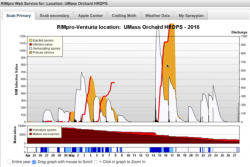
by Jon Clements and Daniel Cooley, UMass Amherst
Online Decision Support Systems (DSS’s) provide guidance in managing disease and insect pests using weather based forecasting models. These DSS’s predict pest development and risk of infection/damage. Weather data can be acquired from either on-site weather stations or by virtual gridded data. For 2017, Massachusetts apple growers have a choice of four DSS’s, which are briefly outlined below.
SkyBit E-Weather (skybit.com) is a commercial service that provides weather data and model output via daily e-mails...
- Weather data - virtual, gridded, customer provides location details
- User interface - daily e-mail
- Models - apple scab, fire blight, sooty blotch/flyspeck, codling moth, oblique-banded leafroller, apple maggot fly, and more; also daily weather history and forecast and spraying conditions (wind, drying)
- Cost - $50 per site, plus $10 each for disease and/or insect models per month; can be turned on or off at will, but recommended period is April-September
Ag-Radar (agradar.info) is run by Glen Koehler at the University of Maine and uses Skybit subscription data to run many, many disease/insect and horticulture models and tools...
- Weather data: virtual, provided by Skybit subscription
- User interface: website
- Models: apple scab, fire blight, sooty blotch/flyspeck, codling moth, oblique-banded leafroller, apple maggot fly, plum curculio, and many more; also horticultural tools such as bud stage prediction, fruit thinning conditions, and harvest date predictions; spray residue depletion
- Cost: Free, however, one must provide daily hourly weather observations to AgRadar via SkyBit subscription at a cost of $55 per month
Network for Environment and Weather Applications (NEWA) (newa.cornell.edu) provides weather data and model outputs by a network of weather stations of which there are currently 46 in Massachusetts…
- Weather data: on-site weather stations, mostly in orchards but also at airports
- User interface: website
- Models: apple scab, fire blight, sooty blotch/flyspeck, codling moth, oblique-banded leafroller, apple maggot fly, plum curculio, and several more; also horticultural tools including Apple Carbohydrate Thinning and Apple Irrigation
- Cost: Free, cost of supporting the Massachusetts NEWA state network provided by UMass Extension (NEWA annual fee $1,750), plus in-kind support (ongoing maintenance and troubleshooting) by growers who have stations and UMass Extension
RIMpro (www.rimpro.eu) is a European-based cloud service that produces mostly graphical model outputs in greater detail than the other DSS’s mentioned above…
- Weather data: either on-site NEWA weather stations or virtual data provided by meteoblue
- User interface: website
- Models: apple scab, fire blight, codling moth, European apple sawfly, weather data; spray residue depletion
- Cost: 200 Euros per site payable by Pay Pal for an individual account, plus $50 for NEWA data or 50 Euros for meteoblue
Note that all these DSS’s require user input in terms of setting biofixes (when things happen in your orchard), including bud stage (phenology), and in some cases pheromone trap captures. Also, there is typically some initial setup involved, however, anyone can visit NEWA or Ag-Radar to view model outputs and pest management tools. You are encouraged, however, to get your own site set up on one of these DSS’s as it will be more accurate than a site that is “close to you." You will find these important tools for Integrated Crop Management should help you produce a better apple crop in 2017.
If you have any questions, please contact Jon Clements, jon.clements@umass.edu 413-478-7219.
